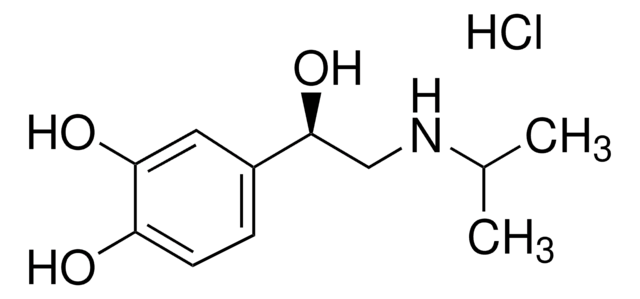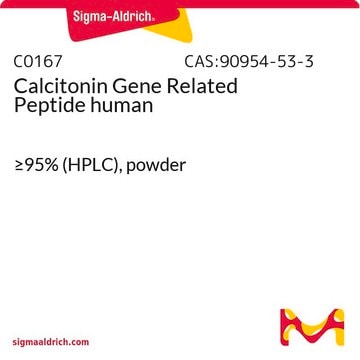S6883
Substance P acetate salt hydrate
≥95% (HPLC), powder
About This Item
Produits recommandés
Niveau de qualité
Pureté
≥95% (HPLC)
Forme
powder
Poids mol.
1348 Da by calculation (Average Mass)
Conditions de stockage
(Keep container tightly closed in a dry and well-ventilated place.)
Couleur
white
Solubilité
0.1 M acetic acid: 1 mg/mL
Numéro d'accès UniProt
Température de stockage
−20°C
Chaîne SMILES
[H]O[H].CC(O)=O.CSCC[C@H](NC(=O)[C@H](CC(C)C)NC(=O)CNC(=O)[C@@H](Cc1ccccc1)NC(=O)[C@H](Cc2ccccc2)NC(=O)[C@H](CCC(N)=O)NC(=O)[C@H](CCC(N)=O)NC(=O)[C@@H]3CCCN3C(=O)[C@H](CCCCN)NC(=O)[C@@H]4CCCN4C(=O)[C@@H](N)CCCNC(N)=N)C(N)=O
InChI
1S/C63H98N18O13S.C2H4O2.H2O/c1-37(2)33-45(57(89)74-41(53(68)85)27-32-95-3)73-52(84)36-72-54(86)46(34-38-15-6-4-7-16-38)78-58(90)47(35-39-17-8-5-9-18-39)79-56(88)42(23-25-50(66)82)75-55(87)43(24-26-51(67)83)76-59(91)49-22-14-31-81(49)62(94)44(20-10-11-28-64)77-60(92)48-21-13-30-80(48)61(93)40(65)19-12-29-71-63(69)70;1-2(3)4;/h4-9,15-18,37,40-49H,10-14,19-36,64-65H2,1-3H3,(H2,66,82)(H2,67,83)(H2,68,85)(H,72,86)(H,73,84)(H,74,89)(H,75,87)(H,76,91)(H,77,92)(H,78,90)(H,79,88)(H4,69,70,71);1H3,(H,3,4);1H2/t40-,41-,42-,43-,44-,45-,46?,47-,48-,49-;;/m0../s1
Clé InChI
VHKFRLDSEZYWAC-CIYRQLMPSA-N
Informations sur le gène
human ... TAC1(6863)
Vous recherchez des produits similaires ? Visite Guide de comparaison des produits
Amino Acid Sequence
Description générale
Substance P is a member of the tachykinin family of peptides. It is encoded by the tachykinin precursor 1 (TAC1) gene mapped to human chromosome 7q21-q22. Substance P is a small peptide produced by macrophages, lymphocytes, eosinophils, dendritic cells and nerves. It is part of the neurokinin group.
Application
- used as a neurokinin 1 (NK1) receptor agonist for the activation of spinal nociceptive circuitry in mice
- administered in central nucleus (ACE) in rat to study its positive reinforcing effects
- used in competition binding assays
- used as an inhibitor of myosin light chain kinase in isolated lymphatic vessels from rat
Actions biochimiques/physiologiques
Anticorps
Produit(s) apparenté(s)
Code de la classe de stockage
11 - Combustible Solids
Classe de danger pour l'eau (WGK)
WGK 3
Point d'éclair (°F)
Not applicable
Point d'éclair (°C)
Not applicable
Équipement de protection individuelle
Eyeshields, Gloves, type N95 (US)
Certificats d'analyse (COA)
Recherchez un Certificats d'analyse (COA) en saisissant le numéro de lot du produit. Les numéros de lot figurent sur l'étiquette du produit après les mots "Lot" ou "Batch".
Déjà en possession de ce produit ?
Retrouvez la documentation relative aux produits que vous avez récemment achetés dans la Bibliothèque de documents.
Les clients ont également consulté
Notre équipe de scientifiques dispose d'une expérience dans tous les secteurs de la recherche, notamment en sciences de la vie, science des matériaux, synthèse chimique, chromatographie, analyse et dans de nombreux autres domaines..
Contacter notre Service technique












